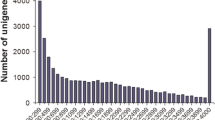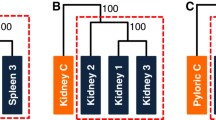Abstract
Gyrodactylid monogeneans are widespread parasites of teleost fishes, and infection with these parasites results in high host morbidity and mortality in aquaculture. To comprehensively elucidate the immune mechanisms against Gyrodactylus kobayashii, the transcriptome profiles of goldfish (Carassius auratus) skin after challenge with G. kobayashii were first investigated using next-generation sequencing. Approximately 21 million clean reads per library were obtained, and the average percentage of these clean reads mapped to the reference genome was 82.25%. A total of 556 differentially expressed genes (DEGs), including 344 upregulated and 212 downregulated genes, were identified, and 380 DEGs were successfully annotated and assigned to 95 signaling pathways in Kyoto Encyclopedia of Genes and Genomes (KEGG). In addition, 14 pathways associated with immune response were identified mainly including mTOR signaling pathway, cytokine-cytokine receptor interaction, intestinal immune network for IgA production, toll-like receptor signaling pathway, and phagosome. Twelve genes were selected and validated using qRT-PCR. A similar trend of these genes between RNA-Seq and qRT-PCR was observed, indicating that RNA-Seq data was reliable. Besides, the ALP activity and NO content in serum were significantly higher in the infected goldfish compared with the non-infected goldfish. In summary, this study provides better understandings of immune defense mechanisms of goldfish against G. kobayashii, which will support future molecular research on gyrodactylids and facilitate the prevention and treatment of gyrodactylosis in aquaculture.




Similar content being viewed by others
References
Bakke TA, Cable J, Harris PD (2007) The biology of gyrodactylid monogeneans: the “Russian-doll killers”. Adv Parasitol 64:161–376
Benjamini Y, Hochberg Y (1995) Controlling the false discovery rate: a practical and powerful approach to multiple testing. J R Stat Soc Ser B Methodol 57(1):289–300
Bogdan C, Mattner J, Schleicher U (2004) The role of type I interferons in non-viral infections. Immunol Rev 202:33–48
Boneberg E-M, Hartung T (2002) Molecular aspects of anti-inflammatory action of G-CSF. Inflamm Res 51(3):119–128
Brunet LR (2001) Nitric oxide in parasitic infections. Int Immunopharmacol 1(8):1457–1467
Buchmann K (1999) Immune mechanisms in fish skin against monogeneans-a model. Folia Parasitol 46(1):1–8
Cable J, Harris PD (2002) Gyrodactylid developmental biology: historical review, current status and future trends. Int J Parasitol 32(3):255–280
Chen S, Zhou Y, Chen Y, Gu J (2018) fastp: an ultra-fast all-in-one FASTQ preprocessor. Bioinformatics 34(17):i884–i890
Collins CM et al (2007) Isolation of a FIP2-like gene from Atlantic salmon (Salmo salar L.), found upregulated following infection with the monogenean parasite Gyrodactylus salaris Malmberg, 1957. Fish Shellfish Immunol 22(3):282–288
Comerford I, Milasta S, Morrow V, Milligan G, Nibbs R (2006) The chemokine receptor CCX-CKR mediates effective scavenging of CCL19 in vitro. Eur J Immunol 36(7):1904–1916
Hu YZ, Li AX, Xu Y, Jiang B, Lu GL, Luo XC (2017) Transcriptomic variation of locally-infected skin of Epinephelus coioides reveals the mucosal immune mechanism against Cryptocaryon irritans. Fish Shellfish Immunol 66:398–410
IBM Corp (2011) IBM SPSS Statistics for Windows, Version 20.0. IBM Corp, New York
Jorgensen TR, Raida MK, Kania PW, Buchmann K (2009) Response of rainbow trout (Oncorhynchus mykiss) in skin and fin tissue during infection with a variant of Gyrodactylus salaris (Monogenea: Gyrodactylidae). Folia Parasitol 56(4):251–258
Keating R, McGargill MA (2016) mTOR regulation of lymphoid cells in immunity to pathogens. Front Immunol 7:180
Keita M, Vincendeau P, Buguet A, Cespuglio R, Vallat JM, Dumas M, Bouteille B (2000) Inducible nitric oxide synthase and nitrotyrosine in the central nervous system of mice chronically infected with Trypanosoma brucei brucei. Exp Parasitol 95(1):19–27
Kim D, Pertea G, Trapnell C, Pimentel H, Kelley R, Salzberg SL (2013) TopHat2: accurate alignment of transcriptomes in the presence of insertions, deletions and gene fusions. Genome Biol 14(4):R36
Lallès J-P (2019) Biology, environmental and nutritional modulation of skin mucus alkaline phosphatase in fish: a review. Fish Shellfish Immun 89:179–186
Lalles J-P (2014) Intestinal alkaline phosphatase: novel functions and protective effects. Nutr Rev 72(2):82–94
Li Y, Xu W, Li X, Jiang H, She Q, Han Z, Li X, Chen Q (2018) Comparative transcriptome analysis of Chinese grass shrimp (Palaemonetes sinensis) infected with isopod parasite Tachaea chinensis. Fish Shellfish Immunol 82:153–161
Lin Y-C, Chen JC, Chen YY, Liu CH, Cheng W, Hsu CH, Tsui WC (2013) Characterization of white shrimp Litopenaeus vannamei integrin β and its role in immunomodulation by dsRNA-mediated gene silencing. Dev Comp Immunol 40(2):167–179
Matejusova I et al (2006) Gene expression profiles of some immune relevant genes from skin of susceptible and responding Atlantic salmon (Salmo salar L.) infected with Gyrodactylus safaris (Monogenea) revealed by suppressive subtractive hybridisation. Int J Parasitol 36(10–11):1175–1183
Roberts RJ, Agius C, Saliba C, Bossier P, Sung YY (2010) Heat shock proteins (chaperones) in fish and shellfish and their potential role in relation to fish health: a review. J Fish Dis 33(10):789–801
Schelkle B, Shinn AP, Peeler E, Cable J (2009) Treatment of gyrodactylid infections in fish. Dis Aquat Org 86(1):65–75
Sedger LM, Seddiki N, Ranasinghe C (2014) Cytokines and cytokine receptors as immunotherapeutics: humble beginnings and exciting futures. Cytokine Growth Factor Rev 25(4):351–353
Shapira M, Zinoviev A (2011) Leishmania parasites act as a trojan horse that paralyzes the translation system of host macrophages. Cell Host Microbe 9(4):257–259
Silke J, Brink R (2009) Regulation of TNFRSF and innate immune signalling complexes by TRAFs and cIAPs. Cell Death Differ 17:35
Silva-Santos B (2012) Driving IL-17+ γδ T-cell migration in allergic reactions: a new “inflammatory” role for the “homeostatic” chemokine CCL25. Eur J Immunol 42(5):1097–1101
Sterud, Harris, Bakke (1998) The influence of Gyrodactylus salaris Malmberg 1957 (Monogenea) on the epidermis of Atlantic salmon, Salmo salar L., and brook trout, Salvelinus fontinalis (Mitchill): experimental studies. J Fish Dis 21(4):257–263
Sudhagar A, Ertl R, Kumar G, El-Matbouli M (2019) Transcriptome profiling of posterior kidney of brown trout, Salmo trutta, during proliferative kidney disease. Parasit Vectors 12(1):569
Trapnell C, Hendrickson DG, Sauvageau M, Goff L, Rinn JL, Pachter L (2012) Differential analysis of gene regulation at transcript resolution with RNA-seq. Nat Biotechnol 31:46
Trapnell C, Williams BA, Pertea G, Mortazavi A, Kwan G, van Baren MJ, Salzberg SL, Wold BJ, Pachter L (2010) Transcript assembly and quantification by RNA-Seq reveals unannotated transcripts and isoform switching during cell differentiation. Nat Biotechnol 28:511–515
Tu X, Qi X, Huang A, Ling F, Wang G (2019) Cytokine gene expression profiles in goldfish (Carassius auratus) during Gyrodactylus kobayashii infection. Fish Shellfish Immunol 86:116–124
Wang P, Wang J, Su YQ, Mao Y, Zhang JS, Wu CW, Ke QZ, Han KH, Zheng WQ, Xu ND (2016) Transcriptome analysis of the Larimichthys crocea liver in response to Cryptocaryon irritans. Fish Shellfish Immunol 48:1–11
Wen J, Song C, Liu J, Chen J, Zhai X, Hu Z (2016) Expression quantitative trait loci for TNFRSF10 influence both HBV infection and hepatocellular carcinoma development. J Med Virol 88(3):474–480
Yin F, Gao Q, Tang B, Sun P, Han K, Huang W (2016) Transcriptome and analysis on the complement and coagulation cascades pathway of large yellow croaker (Larimichthys crocea) to ciliate ectoparasite Cryptocaryon irritans infection. Fish Shellfish Immunol 50:127–141
Zhou S, Li WX, Wang YQ, Zou H, Wu SG, Wang GT (2017a) Anthelmintic efficacies of three common disinfectants and extracts of four traditional Chinese medicinal plants against Gyrodactylus kobayashii (Monogenea) in goldfish (Carassius auratus). Aquaculture 466:72–77
Zhou S, Li WX, Zou H, Zhang J, Wu SG, Li M, Wang GT (2018) Expression analysis of immune genes in goldfish (Carassius auratus) infected with the monogenean parasite Gyrodactylus kobayashii. Fish Shellfish Immunol 77:40–45
Zhou S, Zou H, Wu SG, Wang GT, Marcogliese DJ, Li WX (2017b) Effects of goldfish (Carassius auratus) population size and body condition on the transmission of Gyrodactylus kobayashii (Monogenea). Parasitology 144(9):1221–1228
Zou J, Redmond AK, Qi Z, Dooley H, Secombes CJ (2015) The CXC chemokine receptors of fish: insights into CXCR evolution in the vertebrates. Gen Comp Endocrinol 215:117–131
Funding
This work was supported by China Postdoctoral Science Foundation (2018M642964), Postdoctoral Innovation Project of Hubei Province (2019), National Natural Science Foundation of China (31902417), and Central Public-interest Scientific Institution Basal Research Fund (2019ZD0901).
Author information
Authors and Affiliations
Corresponding author
Ethics declarations
Conflict of interest
The authors declare that they have no conflict of interest.
Additional information
Section Editor: Shokoofeh Shamsi
Publisher’s note
Springer Nature remains neutral with regard to jurisdictional claims in published maps and institutional affiliations.
Rights and permissions
About this article
Cite this article
Zhou, S., Liu, Y., Dong, J. et al. Transcriptome analysis of goldfish (Carassius auratus) in response to Gyrodactylus kobayashii infection. Parasitol Res 120, 161–171 (2021). https://doi.org/10.1007/s00436-020-06827-9
Received:
Accepted:
Published:
Issue Date:
DOI: https://doi.org/10.1007/s00436-020-06827-9




